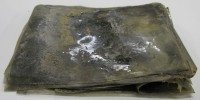 Conservators with the New Zealand Antarctic Heritage Trust have discovered a box holding 22 century-old photographic negatives frozen in a block of ice in explorer Robert Falcon Scott’s supply hut at Cape Evans, Antarctica. Scott built the cabin during his ill-fated last expedition to the South Pole (the Terra Nova Expedition, 1910-1913) that would claim his life. He didn’t leave the pictures behind, though. The photographs were taken during Ernest Shackleton’s Ross Sea Party, part of the 1914-1917 Imperial Trans-Antarctic Expedition. The crew was there in advance of Shackleton on a depot-laying mission to ensure the explorer would have regular supply stops along his route to the South Pole. Ten of them wound up stranded on Ross Island after the team’s ship, the Aurora, blew out to sea on an ice floe during a gale in May of 1915.
Conservators with the New Zealand Antarctic Heritage Trust have discovered a box holding 22 century-old photographic negatives frozen in a block of ice in explorer Robert Falcon Scott’s supply hut at Cape Evans, Antarctica. Scott built the cabin during his ill-fated last expedition to the South Pole (the Terra Nova Expedition, 1910-1913) that would claim his life. He didn’t leave the pictures behind, though. The photographs were taken during Ernest Shackleton’s Ross Sea Party, part of the 1914-1917 Imperial Trans-Antarctic Expedition. The crew was there in advance of Shackleton on a depot-laying mission to ensure the explorer would have regular supply stops along his route to the South Pole. Ten of them wound up stranded on Ross Island after the team’s ship, the Aurora, blew out to sea on an ice floe during a gale in May of 1915.
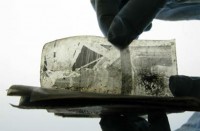 The Antarctic Heritage Trust has been documenting and restoring Scott’s hut, thus far conserving more than 10,000 objects. The exposed but unprocessed cellulose nitrate negatives were found earlier this year clumped together in the darkroom used by Terra Nova Expedition photographer Herbert Ponting. Recognizing this conservation conundrum required the work of a specialist, the Trust sent the negatives back to New Zealand and commissioned Wellington photographic conservator Mark Strange to undo the Gordian Clump.
The Antarctic Heritage Trust has been documenting and restoring Scott’s hut, thus far conserving more than 10,000 objects. The exposed but unprocessed cellulose nitrate negatives were found earlier this year clumped together in the darkroom used by Terra Nova Expedition photographer Herbert Ponting. Recognizing this conservation conundrum required the work of a specialist, the Trust sent the negatives back to New Zealand and commissioned Wellington photographic conservator Mark Strange to undo the Gordian Clump.
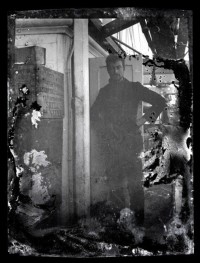 He painstakingly peeled the nitrate layers apart, cleaning them and removing copious mold, revealing 22 photographs from the Ross Sea Party taken between December 1914 and January 1915, just four months before the stranding on Ross Island. The Aurora is in several of the pictures, and others were taken from her although she is not visible. Strange was able to rescue them sufficiently so that New Zealand Micrographic Services could scan them. The digital scans were then converted to positives.
He painstakingly peeled the nitrate layers apart, cleaning them and removing copious mold, revealing 22 photographs from the Ross Sea Party taken between December 1914 and January 1915, just four months before the stranding on Ross Island. The Aurora is in several of the pictures, and others were taken from her although she is not visible. Strange was able to rescue them sufficiently so that New Zealand Micrographic Services could scan them. The digital scans were then converted to positives.
The images look otherworldly, even ghostly through the splotches, scratches and mold-stained edges, but the Antarctic Heritage Trust researchers were able to identify locations and people among the eerily beautiful stretches of footsteps in snow and nearly featureless horizons of 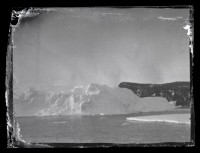 ocean and sky. There are shots of Hut Point Peninsula, Tent Island and Big Razorback Island in McMurdo Sound, taken from the deck of the Aurora. One of them captures Alexander Stevens, the Ross Sea Party’s chief scientist and geologist and an apposite handsome model, standing on the deck with land and iceberg contrasting in the background. He’s in another picture on board the ship too, standing next to a stack of Shell Benzine cases on the left.
ocean and sky. There are shots of Hut Point Peninsula, Tent Island and Big Razorback Island in McMurdo Sound, taken from the deck of the Aurora. One of them captures Alexander Stevens, the Ross Sea Party’s chief scientist and geologist and an apposite handsome model, standing on the deck with land and iceberg contrasting in the background. He’s in another picture on board the ship too, standing next to a stack of Shell Benzine cases on the left.
Trust executive director Nigel Watson:
“It’s the first example that I’m aware of, of undeveloped negatives from a century ago from the Antarctic heroic era. There’s a paucity of images from that expedition,” Watson said.
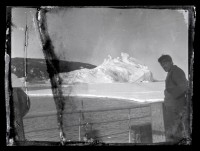 Trust researchers have not been able to confirm the identity of the photographer. Arnold Patrick Spencer-Smith was the Ross expedition’s photographer, so in all likelihood it’s his work. Unfortunately Spencer-Smith did not survive his stranding. The Aurora limped into Dunedin, New Zealand on April 3rd, 1916. It needed extensive repairs and refitting and there was no money to do it. Finally the Australian, New Zealand and British governments funded a rescue mission and the Aurora set off, with Shackleton himself on board albeit not in command, to recover its crew. By the time the Aurora returned to Cape Evans in January of 1917, three of the ten crew members left behind had died, the photographer among them. He was buried on the Ross Ice Shelf.
Trust researchers have not been able to confirm the identity of the photographer. Arnold Patrick Spencer-Smith was the Ross expedition’s photographer, so in all likelihood it’s his work. Unfortunately Spencer-Smith did not survive his stranding. The Aurora limped into Dunedin, New Zealand on April 3rd, 1916. It needed extensive repairs and refitting and there was no money to do it. Finally the Australian, New Zealand and British governments funded a rescue mission and the Aurora set off, with Shackleton himself on board albeit not in command, to recover its crew. By the time the Aurora returned to Cape Evans in January of 1917, three of the ten crew members left behind had died, the photographer among them. He was buried on the Ross Ice Shelf.
You can leaf through the pictures on the website of New Zealand’s Antarctic Heritage Trust.